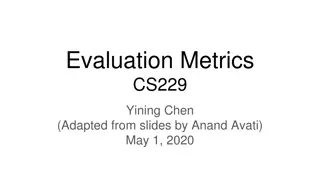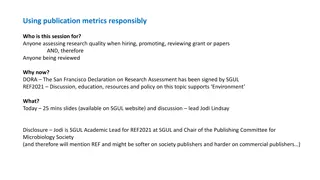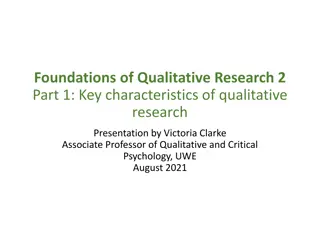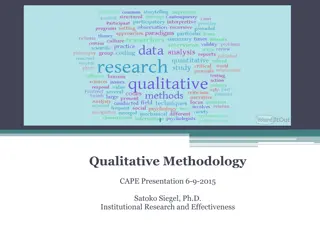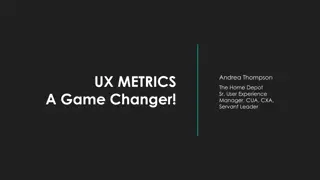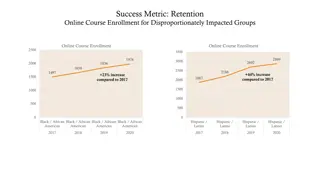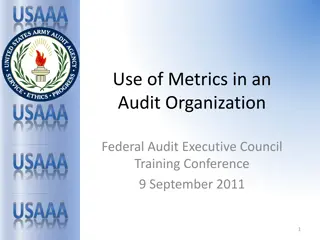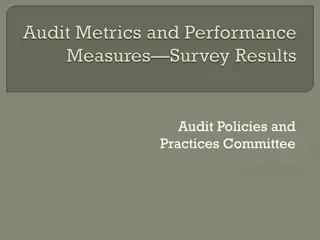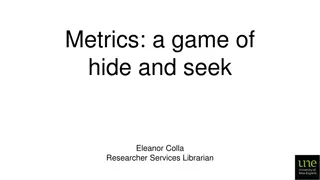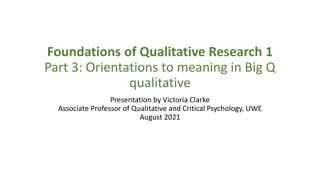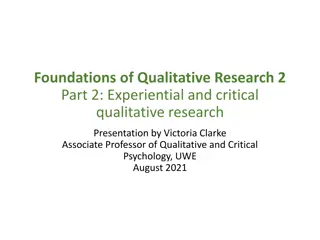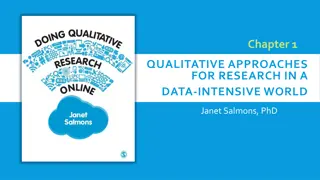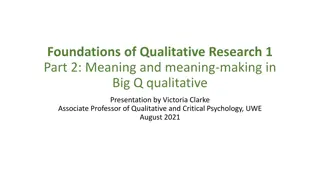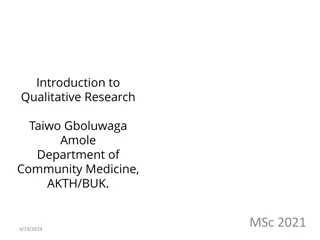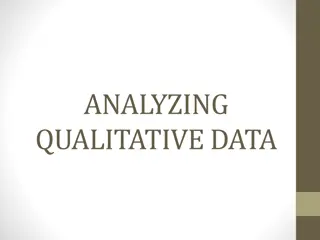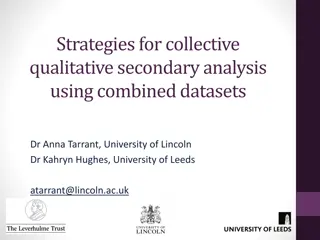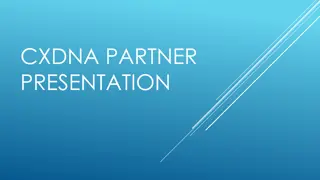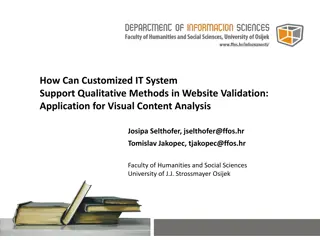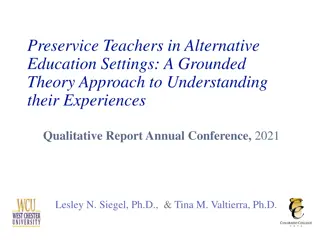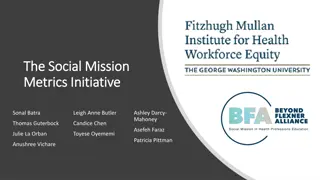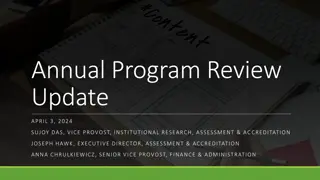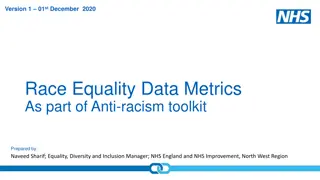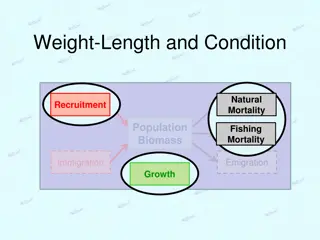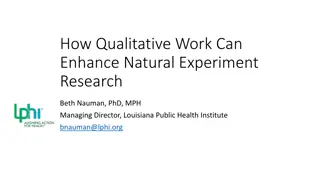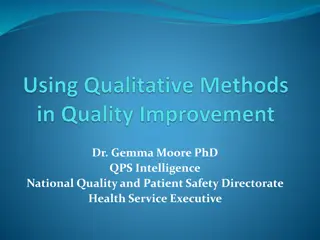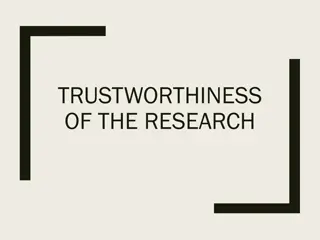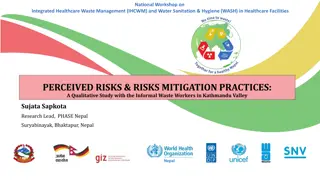Analyzing U.S. Higher Education Success Metrics: A Qualitative Perspective
Delve into the nuances of U.S. higher education success metrics through a qualitative analysis, exploring the classification of qualitative successes in quantitative datasets and the factors influencing accurate or inaccurate classifications. The study involves individuals who attended community colleges and high-ranking university graduate programs, shedding light on the complexities within the system.
Download Presentation

Please find below an Image/Link to download the presentation.
The content on the website is provided AS IS for your information and personal use only. It may not be sold, licensed, or shared on other websites without obtaining consent from the author. Download presentation by click this link. If you encounter any issues during the download, it is possible that the publisher has removed the file from their server.
E N D
Presentation Transcript
A Qualitative Description Analysis of U.S. Higher Education Quantitative Success Metrics Mia Ocean & Karon Hicks
Introduction to Researchers Mia Ocean, MSW, PhD Assistant Professor of graduate social work at West Chester University Karon Hicks, MSW school social worker in Philadelphia
Introduction to Research U.S. system of higher education Quantitative metrics Traditional students University structured programs Complaints and critiques (Covarrubias et al., 2018; Tierney & Clemens, 2011) Performance-based funding (Bailey et al., 2015; McKinney & Serra Hagedorn, 2017) Limited research
Literature Who could universally be considered success stories? Hierarchy in higher education Community colleges Argue access but not success for students (Monaghan & Attewell, 2015). Differences in: Student populations (Doyle, 2009; Ocean et al., 2020) Institutional missions (Bragg, 2001; Cohen et al., 2013) Problematic assumptions imbedded in metrics
Research Questions How would qualitative successes, individuals who attended a community college and a high-ranking social work graduate program, be classified in the U.S. quantitative datasets? What contributed to the accurate or inaccurate quantitative classifications?
Methods Qualitative Description
Participants and Procedure Individuals (n=13) who attended community colleges and high- ranking university graduate programs White=10; Black=1; Asian=1; Portuguese=1 Women=10; Men=3 24-55 years old 1 person identified as an individual with a disability Semi-structured interviews & Educational timelines Audio recorded and transcribed
Classifications Completers or non-completers NELS88 graduate high school for 8 years BPS when begin college for 6 years IPEDS track institutional data Graduation rates first time full time for 3 years Other measures 8 years
Analysis Qualitative description (Sandelowski, 2001; Sandelowski, 2010) Coded transcripts (Brint & Karabel, 1989) Narrative summaries (Way, 1998) Created tables (Miles & Huberman, 1994) Coded data Classifications by database Completer or non-completer Themes across groups (Willis et al., 2016)
Pseudonym NELS Associate NELS Bachelor BPS BPS IPEDS GR IPEDS OM Associate Bachelor Shannon Completer Non-completer Completer Non-completer Non-completer Completer Becky Non-completer Completer Non-completer Completer Non-completer Non-completer Ruby Completer Completer Completer Non-completer Completer Completer Jiyan Not included Not included Non-completer Completer Non-completer Non-completer Tim Non-completer Non-completer Non-completer Non-completer Non-completer Non-completer Katherine Non-completer Completer Non-completer Completer Not included Non-completer J Not included Not included Non-completer Non-completer Not included Completer Paige Completer Completer Completer Completer Completer Completer Karen Non-completer Non-completer Completer Non-completer Non-completer Completer Caneron Erickson Completer Completer Completer Completer Completer Completer Emma Non-completer Non-completer Non-completer Non-completer Non-completer Non-completer Marie Completer Completer Completer Completer Completer Completer Jasmine Completer Completer Completer Completer Completer Completer
Completers n=4 were classified as completers across all datasets Traditional students Marie: in the summer, I had such a great time with my girlfriends. We were goin into [city] all the time, and goin nightclubbin , So after work we d go out partyin , doin our thing. So by August my mother said to me, So what school have you chosen? I said, I m not gonna go to college. I think I m gonna take a year off, and um, [pause] then I ll figure do. I think I ll be a secretary. She said, Not in this house. You either pick a school, or you re, gonna get your own apartment, pay your own utilities, get your own phone-- And I got frightened. I said, I can t do that So I got on the bandwagon out what I want to Adequate supports Jasmine: I don t know how I m gonna pay for this. I don t qualify for financial aid, as somebody who s undocumented, so I guess, let s see if family could help me I was lucky enough that at the time, my father did help. Um, and it was cheap enough that he was able to help. So I think that s what saved me, too.
Non-Completers 1stTheme Transfer prior to Associate degree completion Jiyan: They have some sort of uh placement or an agreement with uh with [state university] if you graduate with a certain um GPA [grade point average] and with a certain numbers of um credits you are automatically accepted if you apply and if you meet the criteria of course so that transition was easy.
Non-Completers 2ndTheme Limited timelines: Tim: Nah, this isn t for me right now. Emma took classes: on and off so a 2-year degree took me what, 15 years (laughs) to complete Karen: I was raised in a religion that unfortunately higher education was not allowed particularly for girls I was getting older. I m like I love it [horticulture] but do I really want to be working outside because as I get older this is going to only last so long. So I thought, Alright maybe I ll go back to [abbreviation for community college] and again bring my computer skills up to date I could get away with that (laughter) kind of J: so for five years I was working full-time and I went to school sometimes full-time sometimes like three classes
Discussion & Concluding Thoughts Need for qualitative research in higher education Need for updated quantitative metrics Omitting success stories Qualitative description valuable method to evaluate quantitative metrics
References Bailey, T. R., Jaggars, S. S., & Jenkins, D. (2015). Redesigning America s community colleges: A clearer path to student success. Cambridge, MA: Harvard University Press. Bragg, D. D. (2001). Community college access, mission, and outcomes: Considering intriguing intersections and challenges. Peabody Journal of Education, 76(1), 93-116. http://www.jstor.org/stable/1493007 Brint, S., & Karabel, J. (1989). The diverted dream. Oxford University Press. Cohen, A. M., Brawer, F. B., & Kisker, C. B. (2013). The American community college (6th ed.). San Francisco, CA: Jossey-Bass. Covarrubias, A., Nava, P. E., Lara, A., Burciaga, R., V lez, V. N., & Solorzano, D. G. (2018) Critical race quantitative intersections: a testimonio analysis. Race Ethnicity and Education, 21(2), 253-273. https://doi.org/10.1080/13613324.2017.1377412 Doyle, W. R. (2009). The effect of community college enrollment on bachelor s degree completion. Economics of Education Review, 28(2), 199 206. https://doi.org/10.1016/j.econedurev.2008.01.006 McKinney, L. & Serra Hagedorn, L. (2017). Performance-Based funding for community colleges: are colleges disadvantaged by serving the most disadvantaged students? The Journal of Higher Education, 88(2), 159-182. https://doi.org/10.1080/00221546.2016.1243948 Miles, M.B. & Huberman, A.M. (1994). Qualitative data analysis: An expanded sourcebook (2nd ed.). Thousand Oaks, CA: SAGE.
References Monaghan, D. B., & Attewell, P. (2015). The community college route to the bachelor s degree. Educational Evaluation and Policy Analysis, 37(1), 70 91. https://doi.org/10.3102/0162373714521865 Ocean, M., McLaughlin, J. A., & Hodes, J. (2020). We take EVERYONE : Perceptions of external assessment and accountability at the community college. Community College Journal of Research and Practice. https://doi.org/10.1080/10668926.2020.1841041 Sandelowski, M. (2000), Whatever happened to qualitative description? Research in Nursing & Health, 23(4), 334-340. https://doi.org/10.1002/1098-240X(200008)23:4<334::AID-NUR9>3.0.CO;2-G Sandelowski, M. (2010), What's in a name? Qualitative description revisited. Research in Nursing & Health, 33(1), 77-84. https://doi.org/10.1002/nur.20362 Tierney, W. G. & Clemens, R. F. (2011). Qualitative research and public policy: The challenges of relevance and trustworthiness. In J. C. Smart & M. B. Paulsen (Eds.), Higher Education: Handbook of Theory and Research (pp. 57-83). New York, NY: Springer. Way, N. (1998). Everyday courage: The lives and stories of urban teenagers. New York: New York University Press. Willis, D. G., Sullivan-Bolyai, S., Knafl, K., & Cohen, M. Z. (2016). Distinguishing features and similarities between descriptive phenomenological and qualitative description research. Western Journal of Nursing Research, 38(9), 1185 1204. https://doi.org/10.1177/0193945916645499
Thank you Comments Q&A Let s connect and collaborate Email: mocean@wcupa.edu https://www.linkedin.com/in/mia-ocean/


